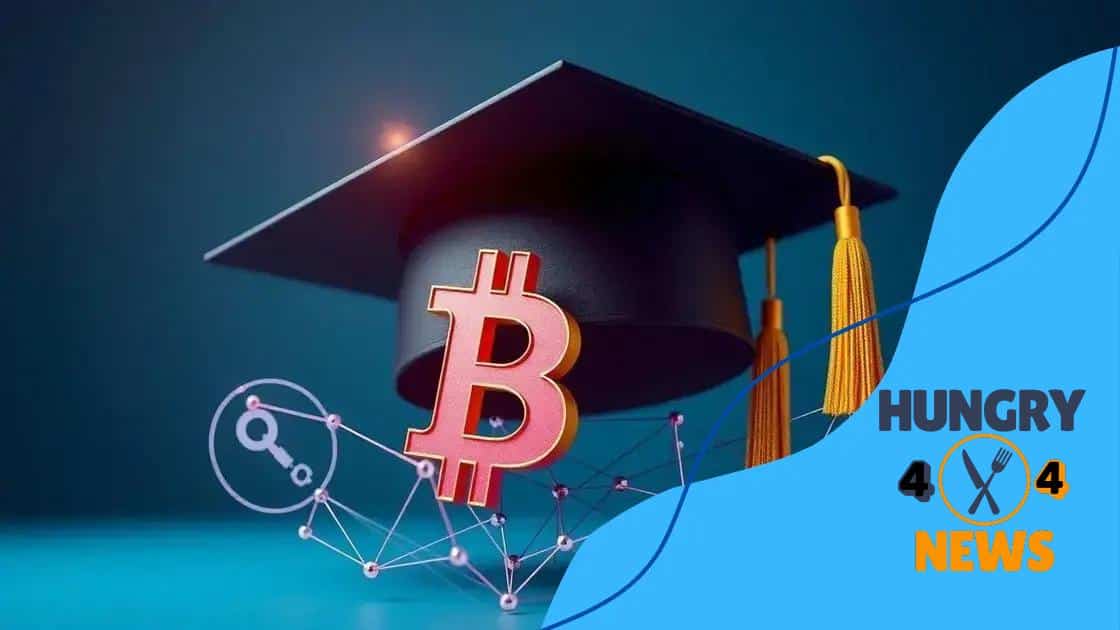Blockchain for securing academic records: a game changer

Blockchain for securing academic records enhances security, streamlines verification processes, and allows for innovative applications like digital diplomas, transforming the management of educational credentials.
Blockchain for securing academic records is transforming how institutions verify credentials. Have you ever worried about diploma fraud? This technology provides a reliable way to enhance trust in educational qualifications.
Understanding blockchain technology
Understanding blockchain technology is crucial in today’s digital world. This innovative system offers a secure way to store and share information. To begin with, imagine a digital ledger that records transactions across many computers. This means the records are not kept in one place, making them less vulnerable to corruption.
What is blockchain?
At its core, blockchain is a list of records called blocks. Each block is linked to the previous one, forming a chain. This chain is public and can be viewed by anyone, providing transparency. Each time a transaction occurs, it is added to a block. The block is then confirmed by a network of computers called nodes. Once confirmed, it cannot be altered, ensuring the information remains secure and trustworthy.
Key features of blockchain technology
- Decentralization: No single entity controls the entire blockchain. This reduces the risk of fraud.
- Transparency: Changes to the blockchain are visible to all users, promoting trust.
- Security: Strong cryptographic methods protect the data, making it nearly impossible to tamper with.
- Immutability: Once data is recorded on the blockchain, it cannot be changed or deleted.
Understanding how blockchain technology operates can help us explore its applications, especially in areas like securing academic records. The benefits this technology brings to the table are enormous. For example, it can help prevent academic dishonesty by allowing institutions to verify credentials easily. This streamlined process removes the hassle of manual checks.
In addition, blockchain can automate the verification process through smart contracts. These contracts automatically execute actions when pre-set criteria are met. This means less administrative work and more reliability in verifying academic achievements. As more institutions adopt this technology, we can expect a shift towards a more secure and efficient way of managing educational records.
Benefits of using blockchain in education
The benefits of using blockchain in education are transforming how institutions manage student records and credentials. With the rise of digital technology, the need for secure and efficient systems has never been greater. Blockchain offers innovative solutions that enhance trust and transparency.
Enhanced security
One of the primary advantages of blockchain is its enhanced security. Each record is encrypted and linked to the previous one, creating a secure chain. This makes it incredibly difficult for anyone to alter or forge academic credentials. Students and institutions can trust that the information is accurate and safe.
Efficiency in verification
Blockchain can significantly increase efficiency in verifying student records. Traditionally, verifying academic achievements involves tedious, time-consuming processes. With blockchain, institutions can access verified data quickly. This streamlines the whole verification process, reducing time and effort for both students and schools.
- Instant access: Authorized parties can instantly access verified records.
- Reduced fraud: Tamper-proof records prevent academic dishonesty.
- Cost savings: Lower administrative costs due to automated processes.
- Global recognition: Credentials can be verified anywhere, increasing portability.
Moreover, incorporating blockchain into education fosters a culture of ownership among students. As learners know their records are securely stored, they feel more empowered to maintain their educational achievements. This leads to improved motivation and engagement, as students understand the value of their credentials.
Educational institutions that adopt blockchain also benefit from improved reputation and competitiveness. By offering secure and transparent record-keeping methods, these institutions stand out in a crowded market. As more schools embrace this technology, the landscape of education continues to evolve, paving the way for future advancements.
Real-world applications of blockchain in academia

The real-world applications of blockchain in academia are reshaping how educational institutions operate. This technology offers practical solutions to common challenges faced by schools and universities. One significant application is in securing student records and credentials.
Credential verification
Blockchain technology allows for rapid and secure verification of academic credentials. Instead of relying on lengthy background checks, employers and institutions can verify qualifications almost instantly. This system is more trustworthy and minimizes the chances of fraud.
Digital diplomas
Many universities are now issuing digital diplomas on blockchain, which students can easily share with potential employers. These diplomas are tamper-proof and can be verified by anyone in seconds. This innovation is gaining momentum, making it easier for graduates to prove their qualifications.
- Transparent records: All transactions are recorded on a public ledger, visible to all parties involved.
- Smart contracts: Automate the process of issuing diplomas and verifying student achievements, reducing administrative workloads.
- Secure data sharing: Institutions can share students’ records with other educational entities while maintaining privacy and security.
- Improved accessibility: Students have easy access to their own academic records, promoting ownership and accountability.
Beyond credentials, blockchain can help in research collaboration. Universities can work together across borders, sharing data and findings securely. This leads to faster advancements in research and innovation, benefiting the entire academic community.
As more institutions recognize the value of blockchain, we can expect its applications to expand even further. Solutions like anonymous peer reviewing and secure data sharing in research also showcase the technology’s versatility. Blockchain is truly transforming the landscape of education and research.
Challenges in implementing blockchain solutions
Implementing blockchain solutions in academia comes with various challenges. These hurdles can slow down the adoption of this promising technology. Understanding the difficulties is key to finding effective solutions.
Technical complexities
One of the main challenges is the technical complexity of blockchain systems. Many educational institutions may lack the technical expertise needed to implement and maintain these systems. This can lead to delays in adoption. Moreover, ensuring that the blockchain infrastructure is secure and scalable adds another layer of complexity.
Integration with existing systems
Another issue is integrating blockchain technology with existing systems. Many institutions have legacy systems that are crucial for their operations. Transitioning to a new service requires careful planning and resources. This can lead to resistance from staff who are accustomed to traditional methods.
- Training requirements: Staff may need specific training to understand blockchain.
- Cost considerations: Initial setup costs can be significant, making some institutions hesitant.
- Regulatory concerns: Institutions must navigate various legal and regulatory frameworks.
- Data privacy: Ensuring user data remains private while using blockchain can be challenging.
Furthermore, institutions need to consider the long-term sustainability of blockchain solutions. While the technology has great potential, institutions must ensure that they can maintain and update their blockchain systems over time. This ongoing commitment can be seen as a burden by some institutions.
The need for collaboration among academic institutions, tech companies, and policymakers becomes evident as these challenges surface. By working together, stakeholders can create a roadmap that outlines best practices and strategies for overcoming these hurdles. Addressing these challenges head-on will pave the way for a smoother implementation of blockchain in education.
Future of blockchain in securing academic records
The future of blockchain in securing academic records appears promising as more institutions recognize its potential. As technology continues to evolve, the integration of blockchain into educational systems will likely become more widespread. This shift can significantly enhance the way records are maintained and shared.
Increased adoption rates
More universities and colleges are beginning to implement blockchain solutions. The growing recognition of its benefits, such as security and efficiency, encourages institutions to adopt this technology. As success stories emerge, more organizations will likely follow suit, leading to greater acceptance in the academic community.
Innovative applications
We can expect to see innovative applications of blockchain in education. This includes not only secure record keeping but also advanced features that can transform the student experience. For example, blockchain can facilitate secure degrees and transcripts that students can easily share with employers. Such features will streamline the hiring process and improve transparency.
- Interoperability: Future systems may support seamless data sharing across different platforms and institutions.
- Smart contracts: These can automate processes, such as issuing credentials, which saves time and reduces administrative burdens.
- Expanded portfolio management: Students may have the ability to manage their entire academic history in one secure space.
- Enhanced collaboration: Institutions may collaborate more effectively by sharing data securely and transparently.
The potential for improved data analytics is another exciting aspect of the future. As more data is securely stored on blockchain, educational institutions can analyze trends and improve educational outcomes. This data-driven approach can lead to more personalized learning experiences for students.
Overall, the outlook for blockchain in education is bright. As barriers to adoption are overcome, we can expect a transformative impact on how academic records are created, stored, and shared. The possibilities are endless, and institutions that embrace this technology will lead the way in shaping the future educational landscape.
In conclusion, the integration of blockchain technology in securing academic records holds great promise for the future of education. As more institutions recognize its numerous benefits, such as enhanced security, efficiency in verification, and innovative applications, the path is being paved for a transformation in how records are managed. While challenges exist in implementing these solutions, such as technical complexities and integration issues, the ongoing collaboration between educational institutions, technology companies, and policymakers will lead to successful adoption. The future is bright for blockchain in education, offering improved experiences for students and institutions alike.
\n\n
\n
FAQ – Frequently Asked Questions about Blockchain in Securing Academic Records
What are the main benefits of using blockchain in education?
Blockchain enhances security, improves the efficiency of record verification, and allows for innovative applications like digital diplomas.
What challenges do institutions face when implementing blockchain?
Institutions may encounter technical complexities, integration issues with existing systems, and the need for staff training.
How can blockchain improve the student experience?
Blockchain allows for secure, easy access to academic records, enabling students to share their credentials seamlessly with employers.
What does the future hold for blockchain in academia?
The future looks bright as more institutions adopt blockchain for record management, leading to enhanced security and new applications in education.





